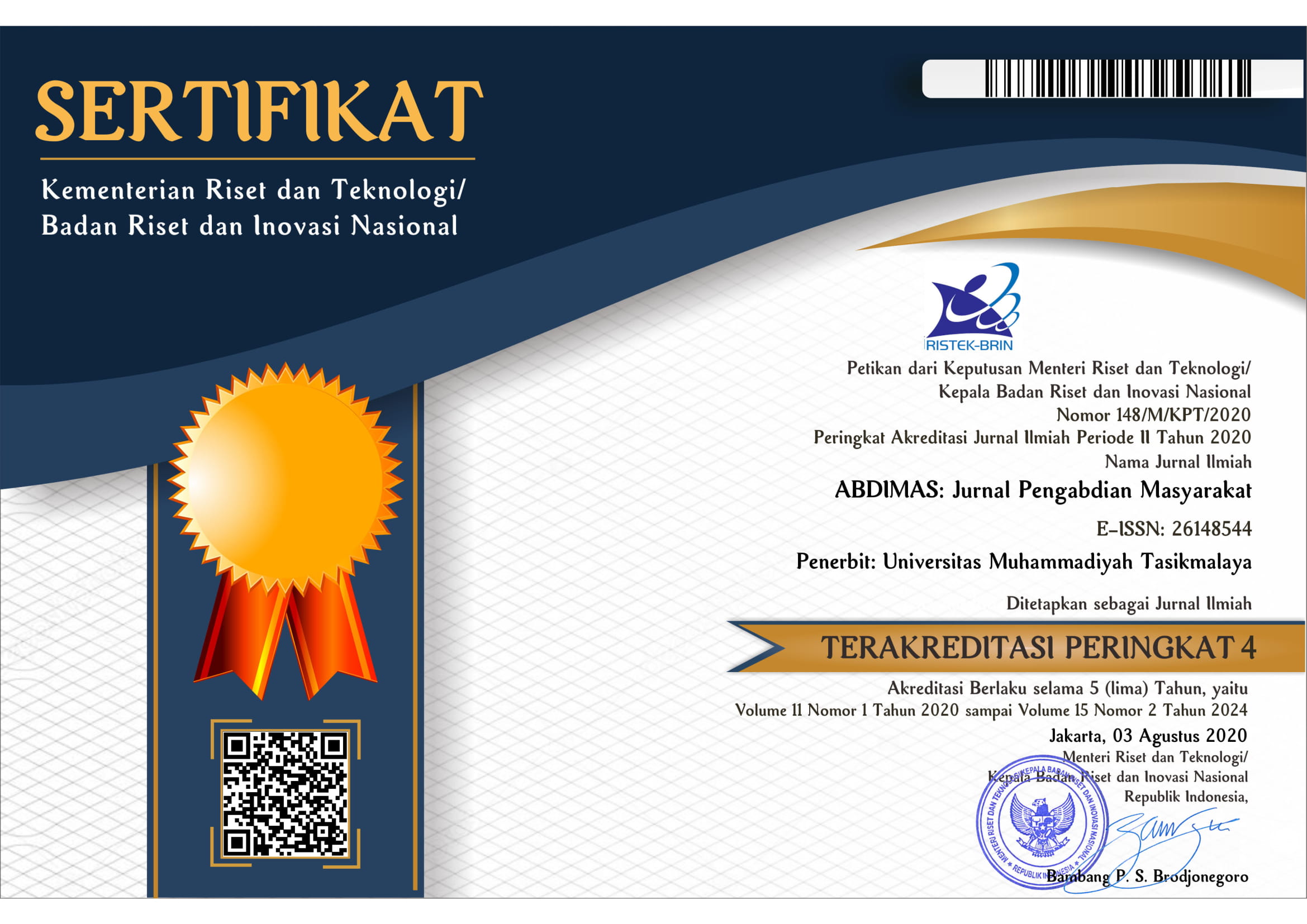Increased Community Awareness Against Flood Management
DOI:
https://doi.org/10.35568/abdimas.v6i1.2906Keywords:
flood disaster, flood management, river rasin, Early Warning System (EWS)Abstract
During the rainy season, many areas in Malang are prone to flooding, especially areas near rivers. Samaan Village is part of the Brantas River Basin, which has a source of water flow from Sumber Luh in the Brantas River area. Four neighbourhoods in this kelurahan are located in the river basin. The flood disaster in Malang City at the end of 2021 was the result of flooding that occurred in Batu City. This flood event was the worst after the flood in 2004. The flash flood caused many material losses, one of which damaged the newly built Taman Keceh tourist attraction.
The activities offered from this PKM are socialisation, mentoring and training activities related to flood disaster management for communities around the Brantas River. This activity aims to equip the community with understanding and skills in flood disaster management. The implementation of disaster management consists of 3 (three) stages, including pre-disaster, during disaster (emergency response), and post-disaster (rehabilitation and reconstruction). The methods used in this activity included deliberation, brainstorming, and demonstration. In the process, the participants were accompanied by resource persons and the service implementation team as facilitators. During the series of processes, an evaluation was carried out as monitoring and improvement of activities.
The results of this activity include (1) increased community awareness in flood disaster management, (2) the availability of Early Warning System (EWS) both traditional and modern simple ones as an effort to mitigate flood disasters, and (3) the formation of cooperation between local communities in flood disaster management (pre, during, and post).
Downloads
References
H, M. D., Alviansyah, M., & Hansen, H. (2022). Community Empowerment of Ponoragan Village,
Loa Kulu District Through Education and Composing with The Takakura Method. ABDIMAS:
Jurnal Pengabdian Masyarakat, 5(2), 2212–2218. https://doi.org/10.35568/abdimas.v5i2.1866
Andriani. 2020. Evaluasi Kegiatan Pengabdian Kepada Masyarakat Dosen Universitas Lancang
Kuning. JUPIIS: Jurnal Pendidikan Ilmu-Ilmu Sosial, 12(1). DOI:
https://doi.org/10.24114/jupiis.v12i1.14680.
Detik. 10 Nov 2022. Hujan Deras Guyur Kota Malang, 14 Titik Terendam Banjir. Diakses 11
November 2022.
Kementrian PUPR-BPSDM. 2017. Modul 11: Penanggulangan Bencana Banjir. Bandung: Pusat
Pendidikan Dan Pelatihan Sumber Daya Air dan Konstruksi.
Kodoatie, Robert, J dan Roestam Sjarief (2006): Pengelolaan Bencana Terpadu. Penerbit Yarsif
Watampone, Jakarta.
Listyaningrum, R. A. ., Ishaq, M. ., Purwito, L. ., & Widianto, E. . (2022). ’Taman Keceh’ Tourism
Development Training as a Means of Public Education For the People Around Celaket.
ABDIMAS: Jurnal Pengabdian Masyarakat, 5(1), 1665–1671.
https://doi.org/10.35568/abdimas.v5i1.1697.
Nisa, F. (2014). Manajemen Penanggulangan Bencana Banjir, Puting Beliung, dan Tanah
Longsor di Kabupaten Jombang. JKMP (Jurnal Kebijakan dan Manajemen Publik), 2(2), 103-
Sutarto, J. 2008. Identifikasi Kebutuhan Dan Sumber Belajar Pendidikan Nonformal. Semarang:
UNNES PRESS.
Umeidini, dkk. 2019. Partisipasi Masyarakat dalam Penanggulangan Bencana di Desa
Mekargalih Kecamatan Jatinangor. Focus : Jurnal Pekerjaan Sosial, Vol 2, No 1,
https://doi.org/10.24198/focus.v2i1.23115.
Undang-Undang No.24 Tahun 2007, tentang Penanggulangan Bencana














